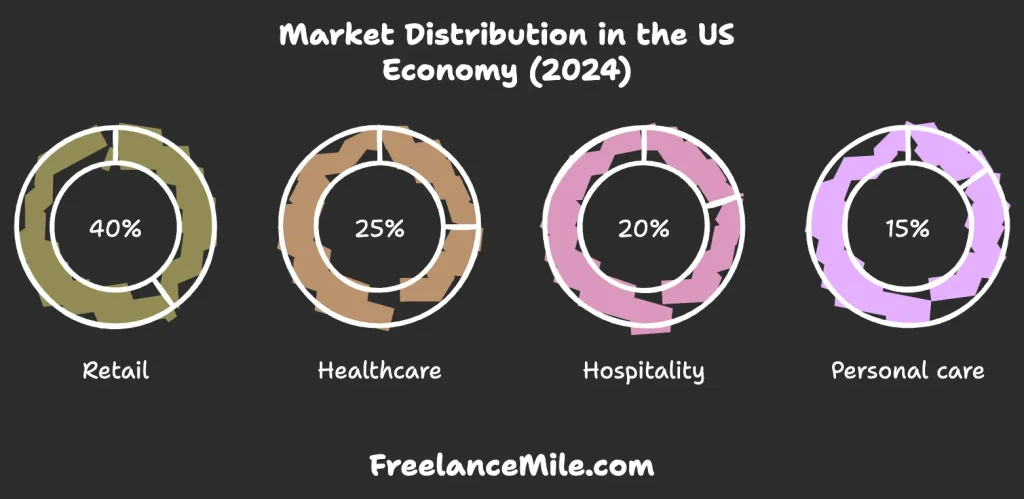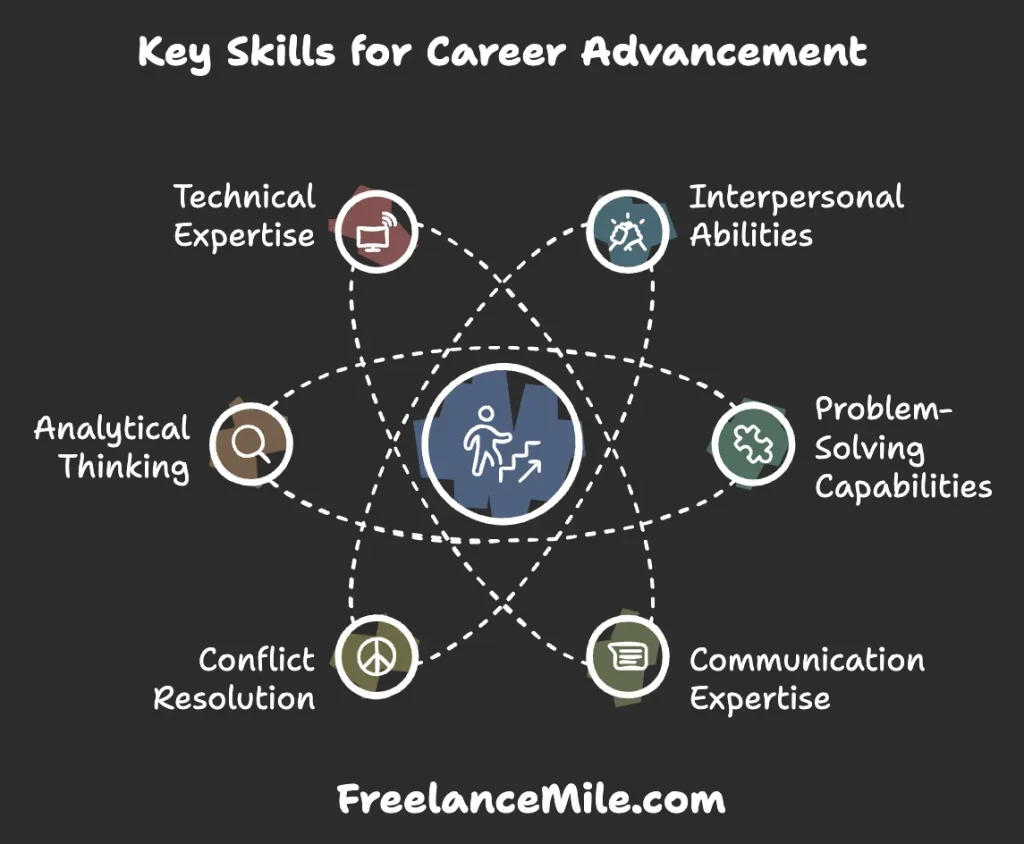The consumer services sector is experiencing remarkable growth, with over 9 million job openings currently available across various specializations. From customer service representatives to retail managers, the industry offers diverse career paths with competitive salaries and advancement opportunities.
Did you know that Over 2.8 million Americans are currently employed as customer service representatives, with nearly 300,000 new customer service job postings in the first six months of 2024. However, the industry faces challenges with retention, as call centers can see turnover rates reaching as high as 44% per year.
Key Takeaways
• The consumer services sector currently offers 9 million job openings with diverse career paths and competitive salaries.
• Healthcare and social assistance sectors are leading growth, anticipated to add 2.1 million jobs over the next decade.
• The global consumer services market has reached over USD 16 trillion in 2024 and is expected to grow to over USD 34 trillion by 2031.
• Technical roles and management positions offer the highest compensation, with salaries ranging from $50,000 to $120,000 annually.
• Remote work opportunities are expanding, with some regions like Colorado having 40% of their workforce operating from home.
How Many Jobs Are Available in Consumer Services: Current Job Market Statistics

Total Employment Numbers
The consumer services sector represents a massive portion of the US workforce, with over 140 million people currently employed and approximately 9.1 million service sector jobs available. A remarkable 79% of the US workforce is employed in the service sector, highlighting its dominance in the job market.
Job Distribution by Country
The United States leads globally in consumer services employment, with more positions available than the next four largest markets (China, Japan, Germany, and UK) combined. The global consumer services market has reached over USD 16 trillion in 2024 and is expected to grow to over USD 34 trillion by 2031.
Growth Projections and Trends
Healthcare and social assistance sectors show particularly strong growth potential, projected to add 2.1 million jobs over the next decade, accounting for about 45% of all new jobs. The industry is experiencing significant shifts:
Key Growth Indicators:
- The retail and wholesale sectors report 70% of positions remain unfilled
- The leisure and hospitality sector shows 45% of positions are open
- Healthcare & social assistance is projected to add 2.1 million jobs over the next decade, accounting for about 45% of all new jobs. Four of the 10 industries projected to grow fastest through 2032 come from within this sector.
Industry Turnover:
High churn rates are evident across service sectors:
- Media, entertainment, and sports: 32% churn
- Government and public sector: 29% churn
- Information technology: 29% churn
Regional Job Market Analysis
Job market growth varies significantly by region in the United States:
High Growth Regions:
Several states have experienced 70-100% increases in consumer services job openings from 2020 to 2023, including:
- Nevada
- Colorado
- Minnesota
- North Carolina
- South Carolina
- Arkansas
Moderate Growth Regions:
The Midwest, South, and Texas have seen 40-69% increases in job openings. Meanwhile, the Northeast, Plains states, and West Coast show more modest growth of 10-39%.
Remote work has become a significant factor, with Colorado leading the trend as nearly 40% of its workforce operates from home. This shift to remote work continues to reshape the consumer services landscape, offering more flexibility for employees while expanding the talent pool for employers.
Understanding Consumer Services
Definition of Consumer Services
Consumer services encompass businesses that directly meet the needs of end users, even when they aren’t the direct purchasers of products or services. This broad field includes essential sectors like retail, hospitality, healthcare, and personal care services, representing a global market value of over USD 16 trillion in 2024.
Types of Consumer Services
The industry spans multiple sectors:
Core Service Categories:
- Retail and wholesale commerce
- Healthcare and social assistance
- Travel and hospitality
- Food and dining services
- Technology support
- Transportation services
- Recreation and entertainment
Service Delivery Methods:
Digital transformation has revolutionized service delivery, with organizations increasingly adopting AI and generative AI. By 2025, 80% of customer service & support organizations will use generative AI to improve agent productivity and overall customer experience.
Web-based services now include online appointments, consultations, bill payments, and various B2B, B2C, and C2C business models.
Role and Importance in the Economy
Consumer services play a vital role in driving economic growth and employment:
Economic Impact:
The sector shows remarkable strength, with the global services market valued at USD 16 trillion in 2024, projected to grow to USD 17.5 trillion in 2025.
Market distribution across key sectors includes:

Employment Generation:
The sector is a major employer, with over 130 million Americans working in consumer services positions. The industry continues to grow, particularly in healthcare and social assistance, which is projected to add 2.1 million jobs over the next decade.
Types of Jobs Available
Consumer services offers a diverse range of career opportunities across multiple sectors, with positions available at various skill and experience levels. The field continues to grow, particularly in digital and healthcare services, providing stable employment prospects for job seekers.
Customer Service Representatives
Customer service representatives form the backbone of consumer services, handling customer inquiries and resolving issues across multiple channels. Their primary responsibilities include taking ownership of customer problems, troubleshooting issues, and ensuring customer satisfaction. The role requires excellent communication skills and typically offers entry-level opportunities with growth potential.
Retail Sales Associates
Retail sales associates guide customers through the shopping process from initial greeting to final purchase.
Their key responsibilities include:
- Delivering exceptional service to build brand loyalty
- Maintaining store presentation
- Processing purchases and returns
- Resolving customer complaints professionally
Call Center Representatives
Call center agents manage customer interactions through phone, email, and chat platforms. Their duties encompass:
- Handling incoming and outgoing calls
- Processing orders and payments
- Troubleshooting customer issues
- Recording customer interactions
Technical Support Representatives
Technical support representatives provide specialized assistance for technology-related issues. They must:
- Help resolve technical problems
- Guide users to improve productivity
- Support training program development
- Evaluate system issues
Banking and Financial Services
The financial activities sector offers 565,000 job openings, including positions for:

Hospitality Roles
The leisure and hospitality sector currently has 1.4 million job openings, including positions for:
- Hotel staff
- Food service workers
- Entertainment venue personnel
- Recreation attendants
Healthcare Services
Healthcare services represent a significant growth area, offering various roles requiring different education levels. Positions range from entry-level positions requiring less than one year of training to specialized roles requiring 6-8 years of education.
Travel and Tourism
The travel & tourism sector continues to expand as consumers place increasing value on experiences. This sector includes positions for:
- Travel agents
- Tour guides
- Hospitality managers
- Customer service specialists
Best Paying Consumer Service Jobs
The consumer services sector offers various well-paying career opportunities across different industries. Here’s a detailed breakdown of salaries and responsibilities for key roles:
Flight Attendants
Southwest Airlines flight attendants earn competitive salaries in the aviation industry. Starting pay begins at $33.55 per hour, with the average annual salary reaching $47,079. Experienced flight attendants can earn up to $84.42 per hour, with top earners making around $69,000 annually.
Technical Support Representatives
Technical support representatives typically earn between $50,000 to $90,000 annually, with opportunities for advancement into management positions. Their role involves resolving technical issues and providing customer assistance.
Bank Tellers
Bank tellers earn an average annual salary of $38,400, with wages ranging from $28,800 to $48,000. The average hourly wage is $12.00, with rates varying between $9.00 to $15.00 depending on experience and location.
Event Planners
Event planning professionals command substantial salaries based on their position level:
- Coordinators/Specialists: $64,268
- Managers: $84,622
- Directors: $104,558
- Executive Level/VP: $116,144
Retail Store Managers
Retail store managers oversee daily operations and typically earn between $55,000 to $100,000 annually. Their responsibilities include managing staff, inventory, and ensuring customer satisfaction.
Account Managers
Account managers in consumer services earn between $60,000 to $110,000 annually. They serve as the primary point of contact between businesses and their clients, focusing on maintaining strong relationships and driving customer satisfaction.
Salary and Compensation
The consumer services sector offers diverse compensation packages that vary significantly based on role, location, and experience level.
Average Salary Ranges
Entry-level positions typically start around $30,000 annually, while management roles can exceed $100,0001.
Here’s a breakdown of common positions:
Management Level:
- Store Managers: $75,039 annually
- Sales Managers: $69,411 annually
- Customer Service Directors: $85,000, with potential up to $120,000
Entry and Mid-Level:
- Customer Service Representatives: $35,830 median wage
- Technical Support Specialists: $55,000 median wage
- Client Services Coordinators: $37,681 annually
Factors Affecting Pay
Several key elements influence compensation in consumer services:
Industry Type:
Financial services and healthcare typically offer higher compensation than retail and hospitality sectors. Technical roles, such as programming services and computer systems design, command salaries between $100,000 and $123,000.
Experience Level:
Senior positions require extensive experience and offer significantly higher compensation. Technical support specialists can progress from $40,000 to $80,000 with experience.
Additional Benefits
Most consumer service positions offer comprehensive benefits packages, particularly in larger organizations. These may include:
- Healthcare coverage
- Retirement plans
- Paid time off
- Professional development opportunities
Regional Salary Variations
Geographic location significantly impacts compensation:
High-Paying Regions:
- Metropolitan areas offer higher wages to offset living costs
- Customer service representatives in San Francisco, New York, and Washington D.C. earn $45,000-$60,000 annually
Lower-Paying Regions:
- Midwest and Southern regions typically offer lower salaries
- Retail associates in these areas earn $25,000-$30,000 annually
Career Growth and Opportunities
The consumer services sector offers substantial growth opportunities and promising career advancement paths across various industries.
Career Advancement Paths
Career progression in consumer services typically follows a clear trajectory. Entry-level positions often lead to management roles, with many opportunities for vertical and lateral movement. The sector shows an 11% employment growth rate, indicating strong advancement potential.
Skill Development
Consumer services positions help develop valuable transferable skills:

These skills remain valuable across industries and can benefit professionals throughout their careers. Technical expertise, particularly in AI and digital services, is becoming increasingly important for career advancement.
Industry Growth Projections
The consumer services market shows remarkable growth potential:
- Global market value expected to reach over USD 34 trillion by 2031
- Current market size of over USD 16 trillion in 2024
AI and Automation Trends
The customer service landscape is quickly evolving with AI integration. Organizations are implementing generative AI to automate manual & routine tasks, allowing employees to concentrate on more complex customer needs.
Early adopters report 80% savings in case summary creation time and agents spending 80% less time typing when resolving support requests, resulting in 10% to 20% productivity increases.
Gartner predicts organizations will replace 20% to 30% of their service agents with generative AI by 2026, while also creating new roles to manage this technology. AI agents have shown an impressive growth rate of 44.8% CAGR, indicating this trend will continue through 2025.
Future Job Prospects
The sector’s future looks promising with several key trends:
Growth Areas:
- Healthcare services expansion due to aging populations
- Digital transformation creating new roles
- Travel and hospitality sector recovery
- E-commerce growth driving demand for technical support
Emerging Opportunities:
- AI-driven customer service roles
- Digital marketing positions
- Data analytics specialists
- Experience management professionals4
The industry offers stability and continuous growth potential, with particularly strong prospects in healthcare, technology, and digital services sectors.
Job Satisfaction and Work Environment
Job satisfaction in consumer services depends heavily on workplace culture, management practices, and individual career goals. Here’s a comprehensive look at the key factors affecting job satisfaction in this sector.
Work-Life Balance
The consumer services sector offers varying degrees of flexibility depending on the role. Many positions provide flexible scheduling options, though this can vary by industry and position level. Digital transformation has enabled more remote work opportunities, particularly in technical support and customer service roles.
Job Stability
Consumer services offers strong job security for several reasons:
- Essential services remain stable during economic downturns
- The sector shows consistent growth with a market value of USD 12.2 trillion
- High demand for skilled professionals across various specializations
Career Satisfaction Levels
Career satisfaction in consumer services stems from several factors:
Positive Factors:
- Development of transferable skills
- Opportunities for career advancement
- Meaningful work helping customers
- Diverse job opportunities
Satisfaction Challenges:
- Entry-level positions may offer lower initial compensation
- Dealing with challenging customers can lead to stress
- Workload management can be demanding
Workplace Challenges
Common challenges in consumer services include:
Management Issues:
- Only 32% of employees report being fully engaged at work
- Balancing customer demands with employee wellbeing
- Managing time and workload effectively
Solutions for Improvement:
- Regular training and development opportunities
- Competitive compensation packages
- Implementation of wellness programs
- Career advancement opportunities through promotions and mentoring
Getting Started in Consumer Services
Starting a career in consumer services requires understanding the right qualifications and following effective strategies for entering the field.
Required Qualifications
Many consumer services positions require minimal formal education to start. A high school diploma is often sufficient for entry-level roles, though advanced positions may require bachelor’s degrees. Essential skills include communication, problem-solving, and customer service abilities.
Entry-Level Positions
Several roles offer excellent starting points in consumer services:
Common Starting Positions:
- Marketing coordinator
- Technical support associate
- Bank teller
- Flight attendant
- Receptionist
- Human resources specialist
Training and Certification
Professional development opportunities enhance career prospects:
Key Certifications:
- Customer Experience Professional (CCXP) certification
- Medallia Customer Experience Certification
- Customer Experience Specialist certification
- Customer Service Institute of America certification
Job Search Strategies
To secure a position in consumer services:
Essential Steps:
- Define clear career goals and ideal roles
- Create a tailored resume for each application
- Utilize job search engines effectively
- Build a professional network
- Prepare thoroughly for interviews
Industry Entry Tips:
- Consider internships and community programs
- Focus on social services and healthcare sectors for entry opportunities
- Build professional networks early in your career
Major Employers
The consumer services sector features numerous major employers across different industries, with many offering substantial career opportunities.
Retail Companies
Major retail employers demonstrate significant market presence:
- Amazon employs 1.6 million people globally with revenue of $470 billion
- Target maintains 409,000 employees across all US states
- Costco operates in 8 countries with 214,000 employees
- Home Depot employs 500,000 people across 2,300 stores
Hospitality Companies
The hospitality sector includes several prominent employers:
- Starbucks employs 383,000 people across 80 countries
- McDonald’s maintains 200,000 employees across 120 countries
- Walt Disney employs 190,000 people globally
Healthcare Companies
Healthcare services represent a growing employment sector:
- CVS Health employs 300,000 people, including 40,000 medical professionals
- Healthcare companies are projected to add 2.1 million jobs over the next decade
Financial Services Companies
Financial services offer some of the highest-paying positions in consumer services:
- Bank of America employs 200,000 people
- JP Morgan Chase generates $129,503 million in annual revenue
- Wells Fargo maintains significant market presence
- Goldman Sachs specializes in investment services
These major employers offer various career paths and advancement opportunities, with financial services companies typically providing the highest compensation in the consumer services sector.
Conclusion and Future Predictions
The consumer services sector stands at a pivotal point of transformation and growth. The industry’s evolution is driven by digital innovation, changing consumer behaviors, and demographic shifts. The sector is expected to reach over USD 34 trillion by 2031.
Looking ahead, several key trends will define the industry:
• AI and automation will revolutionize customer service delivery while creating new specialized roles
• Healthcare services will continue expanding due to aging populations
• Digital transformation will accelerate, leading to increased demand for technical support and digital service professionals
• The gig economy will further integrate with traditional consumer services
• Hybrid and remote work models will become more prevalent across service sectors
These changes will create new opportunities while requiring professionals to adapt their skills and embrace technological advancement. The sector’s future remains promising, particularly in healthcare, technology, and digital services, ensuring stable employment prospects for years to come.







